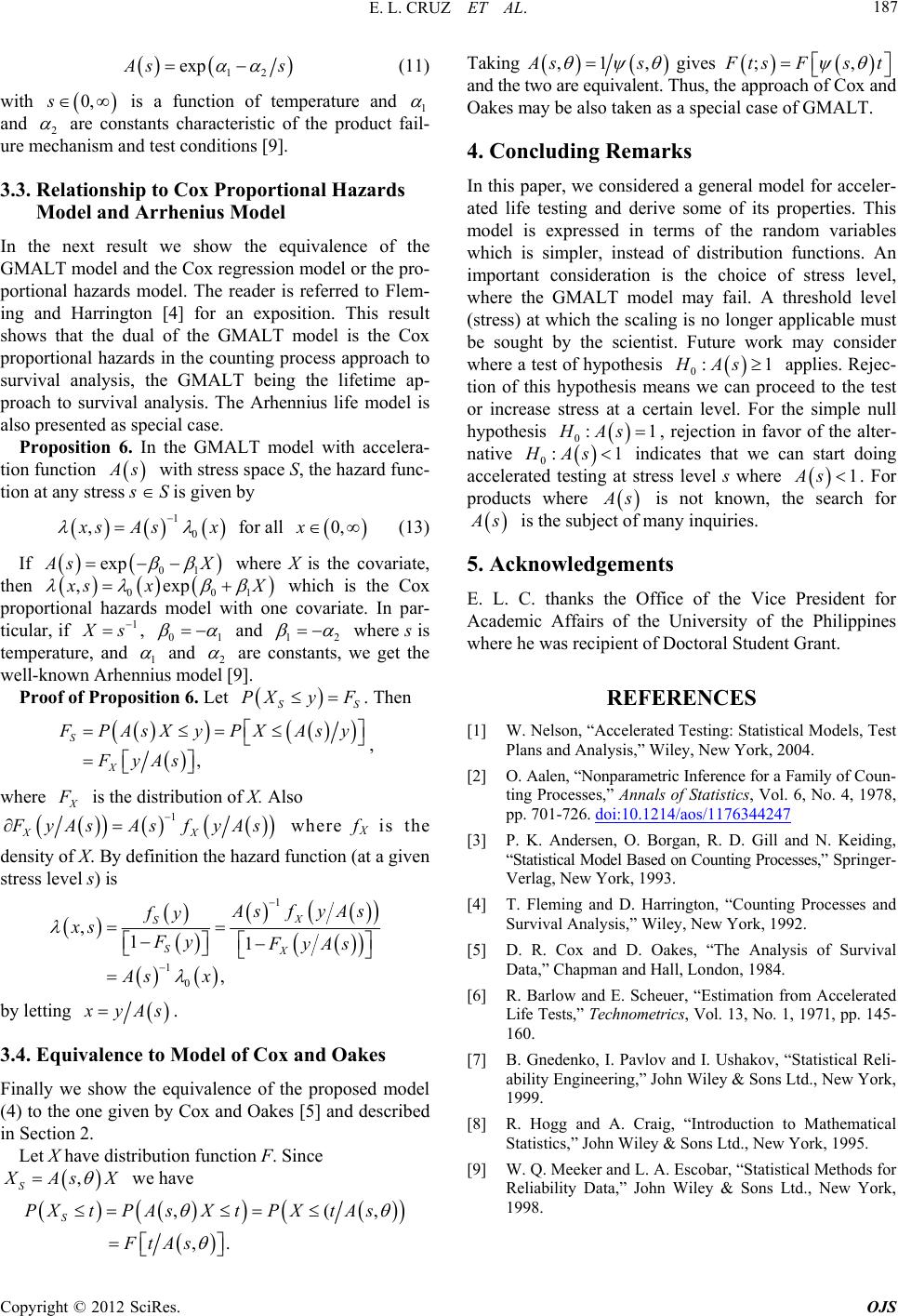
E. L. CRUZ ET AL.
Copyright © 2012 SciRes. OJS
187
12
exp
ss
0,s
(11)
with is a function of temperature and 1
and 2
are constants characteristic of the product fail-
ure mechanism and test conditions [9 ].
3.3. Relationship to Cox Proportional Hazards
Model and Arrhenius Model
In the next result we show the equivalence of the
GMALT model and the Cox regression model or the pro-
portional hazards model. The reader is referred to Flem-
ing and Harrington [4] for an exposition. This result
shows that the dual of the GMALT model is the Cox
proportional hazards in the counting process approach to
survival analysis, the GMALT being the lifetime ap-
proach to survival analysis. The Arhennius life model is
also presented as special case.
Proposition 6. In the GMALT model with accelera-
tion function
s
1
with stress space S, the hazard func-
tion at any stress s S is given by
,
0
sAs
0,x
01
x
for all (13)
If
exp
sX
xp
where X is the covariate,
then 01
0
,e
sx
1
X
which is the Cox
proportional hazards model with one covariate. In par-
ticular, if
s, 01
and 12
where s is
temperature, and 1
and 2
are constants, we get the
well-known Arhennius model [9].
Proof of Propositio n 6. Let . Then
SS
PXy F
,
S
X
PAsX yPX
FyAs
As y
,
where X
is the distribution of X. Also
X
1
X
yAs As
fyAs where fX is the
density of X. By definition the hazard function (at a given
stress level s) is
1
1
0
,11
,
S
SX
X
sfyAs
FyAs
fy
xs Fy
As x
by letting
yAs
,
.
3.4. Equivalence to Model of Cox and Oakes
Finally we show the equivalence of the proposed model
(4) to the one given by Cox and Oakes [5] and described
in Section 2.
Let X have distribution function F. Since
S
As X
we have
, .
S
PXtPAsX tPX
FtAs
,(
,tAs
Taking
,1,
ss
;,
tsFs t
gives
and the two are equivalent. Thus, the approach of Cox and
Oakes may be also taken as a special case of GMALT.
4. Concluding Remarks
In this paper, we considered a general model for acceler-
ated life testing and derive some of its properties. This
model is expressed in terms of the random variables
which is simpler, instead of distribution functions. An
important consideration is the choice of stress level,
where the GMALT model may fail. A threshold level
(stress) at which the scaling is no longer applicable must
be sought by the scientist. Future work may consider
where a test of hypothesis 0 applies. Rejec-
tion of this hypothesis means we can proceed to the test
or increase stress at a certain level. For the simple null
hypothesis
:1HAs
0:1HAs
, rejection in favor of the alter-
native
:1HAs
0
indicates that we can start doing
accelerated testing at stress level s where
1As
. For
products where
s is not known, the search for
s is the subject of many inquiries.
5. Acknowledgements
E. L. C. thanks the Office of the Vice President for
Academic Affairs of the University of the Philippines
where he was recipient of Doctoral Stude nt Grant.
REFERENCES
[1] W. Nelson, “Accelerated Testing: Statistical Models, Test
Plans and Analysis,” Wiley, New York, 2004.
[2] O. Aalen, “Nonparametric Inference for a Family of Coun-
ting Processes,” Annals of Statistics, Vol. 6, No. 4, 1978,
pp. 701-726. doi:10.1214/aos/1176344247
[3] P. K. Andersen, O. Borgan, R. D. Gill and N. Keiding,
“Statistical Model Based on Coun ting Processes,” Sp ri ng e r-
Verlag, New York, 1993.
[4] T. Fleming and D. Harrington, “Counting Processes and
Survival Analysis,” Wiley, New York, 1992.
[5] D. R. Cox and D. Oakes, “The Analysis of Survival
Data,” Chapman and Hall, London, 1984.
[6] R. Barlow and E. Scheuer, “Estimation from Accelerated
Life Tests,” Technometrics, Vol. 13, No. 1, 1971, pp. 145-
160.
[7] B. Gnedenko, I. Pavlov and I. Ushakov, “Statistical Reli-
ability Engineering,” John Wiley & Sons Ltd., New York,
1999.
[8] R. Hogg and A. Craig, “Introduction to Mathematical
Statistics,” John Wiley & Sons Ltd., New York, 1995.
[9] W. Q. Meeker and L. A. Escobar, “Statistical Methods for
Reliability Data,” John Wiley & Sons Ltd., New York,
1998.